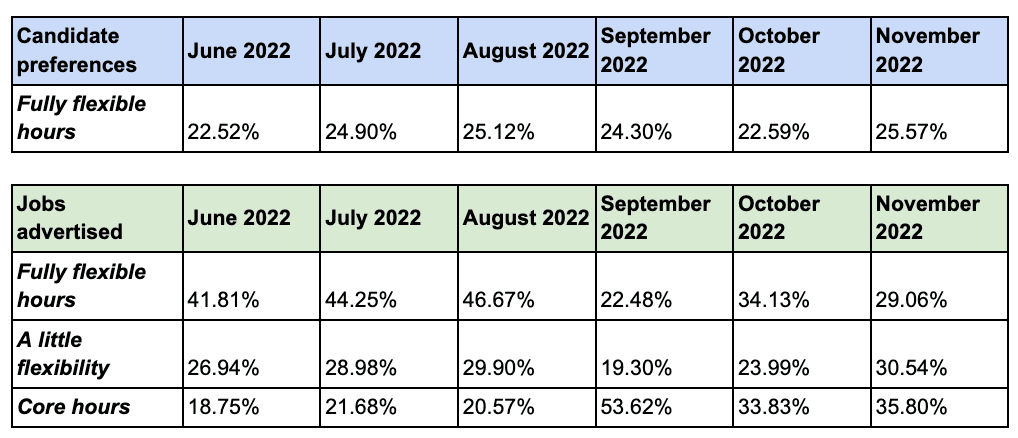Flexible Working Index November: What Job Hunters Are Looking For
9th Dec 2022

November’s Index analysed a sample size of over 1,280 job adverts and the working preferences of 2,143 job hunters. On the Flexa platform, we saw a new record for employees expressing a preference to work ‘fully flexible' hours. We also saw a rising trend amongst employers offering roles with non-traditional working hours
More workers prefer ‘fully flexible’ hours than ever before
In November 2022, more than 1 in 4 workers (26%) said that they’d prefer a role which came with fully flexible hours, where staff complete their working hours whenever they choose. This is a record rate for the Index and up from 23% in October - a rise of 13%.
Slightly fewer workers said that they would prefer roles with ‘core hours’ (whereby staff must work during certain times, e.g. 11am-3pm, but are given flexibility outside of that), or ‘a little flexibility’ over working hours, compared to October figures.
Employees who preferred jobs offering core hours fell by 14% during November - down from 14% to 12%. Preferences for ‘a little flexibility’ around hours fell by 7% (down from 14% to 13%).
Employers are moving towards more flexible working hours
Between October and November, the number of roles advertised as offering fully flexible hours actually fell by 14% (down from 34% to 29%). However, there was an increase in employers advertising roles with a little flexibility or that run on the ‘core hours’ model.
During November, the number of roles advertising ‘a little flexibility’ on hours increased by 29% - up from 24% of all roles in October to 31%.
And roles, where core hours are on offer, rose by 6% - up from 34% to 36%.
Employers and employees prize flexibility on location
When it comes to working location, fully remote roles appear to be in the resurgence.
The number of ‘fully remote’ roles being advertised in November shot up by 67%, compared to the previous month - up from 6% of all roles to 10%. This marks a recovery in the number of fully remote roles on offer.
In comparison, October’s Index saw a 40% drop in fully remote roles being advertised - down from 10% to 6%.
Molly Johnson-Jones, CEO and co-founder of Flexa Careers, comments:
“We’re all familiar with the idea of spending 8 out of our 24 hours each day working, starting at 9am and finishing at 5pm. And for farmers who are limited by daylight hours, or traders who are tied to the opening and closing of the stock market, rigid working patterns might be helpful. But this isn’t necessarily the case for everyone.
“Whether it’s a case of needing to fit the school run or doctor’s appointments around work, or just that individuals find they’re more productive earlier or later in the day - often, set hours simply don’t always work. So it makes sense that we’re seeing the tide turn on traditional working hours.
“This month’s Index saw a record number of workers saying they would prefer fully flexible hours. Employers are also experimenting with relaxing working hours in ways that are practical for them. For many, having teams work together during certain times is proving to be a more sustainable way of answering to the demand for more flexible hours, whilst also keeping distributed teams connected. And we’ll be watching closely as working hours continue to evolve in line with the needs of both businesses and their teams.”
What does this mean for the future of work?
Once again the stats very much show that flexibility is the priority - employees want to be able to make the decision on how, when and where they work (of course, within reason). Whether that be from home, a local coffee shop, abroad (if a work-from-anywhere policy is in place) or start and finish at different times - as opposed to standard 9-5 which was restrictive in terms of building a balanced and improved work-life blend.
In a world where salary is unable to keep up with inflation levels, a business offering choice around flexibility will be favourable to employees and candidates searching for new roles.
Full Flexible Working Data
